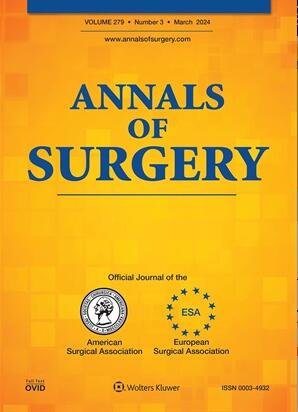Automatic Generation of Liver Virtual Models with Artificial Intelligence: Application to Liver Resection Complexity Prediction.
IF 7.5
1区 医学
Q1 SURGERY
引用次数: 0
Abstract
OBJECTIVE The clinical aim of this work is to predict intraoperative LRC from preoperative CT scans only. SUMMARY OF BACKGROUND DATA Liver resection (LR) is the most prevalent curative treatment for primary liver cancer, yet overall mortality/morbidity rates remain elevated. The conventional definition and classification of LR complexity (LRC) lack inclusion of the disease-induced 3D anatomical surgery complexity. METHODS 3D models of the organ, tumors and blood vessels were generated from Deep Learning models trained on patients CT scans. The surgeons' expertise on which anatomical factors lead to LRC was translated into a new anatomical frame of reference around the Hepatic Central Zone (HCZ). A fully automatic pipeline to generate the HCZ and quantify the tumors position relative to it was assessed. An AI model was then trained to predict LRC from a patient cohort for whom LRC was annotated at the end of each surgery. The AI-prediction was finally compared to prediction of surgeons that only saw the patient preoperative CT scan. RESULTS The 3D reconstructions are successfully evaluated on benchmark datasets. The HCZ is accurately generated for a variety of atypical vascular anatomies (dice score 82±4.6%). The automatic pipeline is successfully run on a 145 HCC patient cohort. The predicted LRC outperforms the surgeons' individual and combined anticipated complexities (accuracy and AUC scores: 79.4±3.4% and 85.1±3.2% respectively). CONCLUSION This automatic digital tool accurately predicts intraoperative LRC and paves the way for an innovative oncology surgery planning. This tool could help orient patients towards appropriate medical centers depending on the predicted LRC level.基于人工智能的肝脏虚拟模型自动生成:在肝切除复杂度预测中的应用。
目的仅从术前CT扫描预测术中LRC的临床目的。背景:肝切除(LR)是原发性肝癌最普遍的根治性治疗方法,但总体死亡率/发病率仍然升高。LR复杂性(LRC)的传统定义和分类缺乏包括疾病引起的三维解剖手术复杂性。方法利用深度学习模型对患者CT扫描进行训练,生成器官、肿瘤和血管的3d模型。外科医生对导致LRC的解剖因素的专业知识被转化为围绕肝中心带(HCZ)的新的解剖参考框架。评估了一个全自动生成HCZ并量化肿瘤相对位置的管道。然后训练人工智能模型,从每次手术结束时注释LRC的患者队列中预测LRC。最后,将人工智能的预测与仅看到患者术前CT扫描的外科医生的预测进行比较。结果三维重建结果在基准数据集上得到了很好的评价。HCZ可准确生成多种非典型血管解剖(骰子得分82±4.6%)。该自动管道在145例HCC患者队列中成功运行。预测的LRC优于外科医生个人和联合预期的复杂性(准确率和AUC评分分别为79.4±3.4%和85.1±3.2%)。结论该自动数字工具可准确预测术中LRC,为创新肿瘤手术规划铺平道路。该工具可以根据预测的LRC水平帮助患者前往合适的医疗中心。
本文章由计算机程序翻译,如有差异,请以英文原文为准。
求助全文
约1分钟内获得全文
求助全文
来源期刊

Annals of surgery
医学-外科
CiteScore
14.40
自引率
4.40%
发文量
687
审稿时长
4 months
期刊介绍:
The Annals of Surgery is a renowned surgery journal, recognized globally for its extensive scholarly references. It serves as a valuable resource for the international medical community by disseminating knowledge regarding important developments in surgical science and practice. Surgeons regularly turn to the Annals of Surgery to stay updated on innovative practices and techniques. The journal also offers special editorial features such as "Advances in Surgical Technique," offering timely coverage of ongoing clinical issues. Additionally, the journal publishes monthly review articles that address the latest concerns in surgical practice.
 求助内容:
求助内容: 应助结果提醒方式:
应助结果提醒方式:


